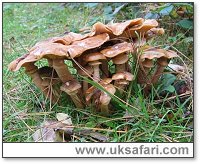
|

|
|
 Sent
to you Sent
to you
by e-mail
|
|
Simply
enter your details and hit the send button
more
info |
|


Click Here

Links
Advertise
Terms of Use
Contributors
About Us
Contact Us
|
 |
Go back
 | Bookmark
| Bookmark
 | Print Page
| Print Page  | E-Mail Us
| E-Mail Us 



Photo: Malcolm Greaves |
|
UK
Safari Tip:
A neat way to identify fungi is with the ID chart in the Nature Shop
called "Fungi Name Trail" - click
here
|
|
Latin name: Armillaria mellea
Size: The caps are about 3cm to 12cm in diameter.
Distribution: Found throughout the UK.
Months seen: June to November.
Habitat: Living or dead trees and shrubs.
Special features: Honey fungus is a parasitic fungus which affects the roots, trunks and stems of dead or damaged plants and trees. It
forms a cream coloured layer of fungus
just below the bark.
The fruiting body is usually yellow-brown to dark brown, and the caps can be
smooth or covered in dark hairy scales. They have a white collar on the stem, just below the cap.
Honey fungus spreads by spores through the air. These normally germinate on
damaged or dead wood.
It can also spread by means of brown-black, stretchy underground roots called 'rhizomorphs'. These rhizomorphs are
made up of a bunch of thread-like filaments (hyphae), all fused together. As they
grow through soil they infect other plants by latching onto their
roots and take away water and nutrients. In this way the honey fungus is capable of attacking and killing many species of trees, especially oaks.
The Latin name 'Armillaria' literally means 'scaly', as in 'Armadillo'. The 'mellea' part comes from
'mel' which is Latin for 'honey'. This probably relates to the colour.
Honey fungus is believed to be edible when cooked young. Great care should be
taken in correctly identifying the species. Even when you get it right, honey fungus can cause
stomach upsets.
Did you know?
Honey fungus rhizomorphs can spread up to 9m (30ft) away from the original
infected plant. One species of honey fungus (Armillaria ostoyae) in America is believed to be the largest living organism on earth. It grows in the Malheur National Forest in east Oregon and is 3.5 miles across.

UK Safari Fungi Section
|
 |

|